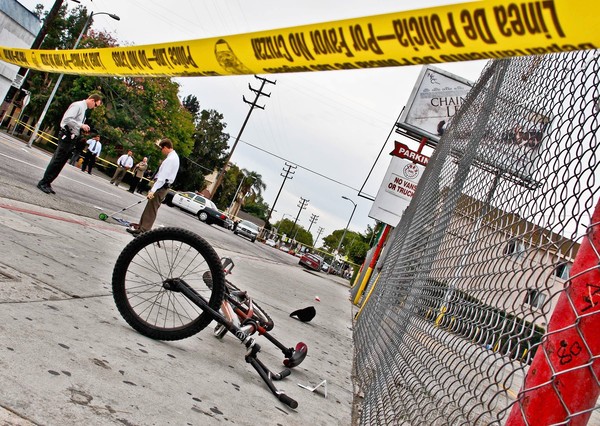
The scene in the Exposition Park area where a man was shot Tuesday morning. |
|
Times launching database that maps, analyzes crime reports across L.A. County
Using daily reports from the LAPD and L.A. County Sheriff's Department, The Times is providing a comprehensive stream of data on serious crimes, tracking trends and offering alerts at the neighborhood level.
by Joel Rubin, Los Angeles Times
September 30, 2010
For car thieves working the streets of Los Angeles County, few stretches of pavement are more attractive than the two blocks of Alondra Boulevard that run from the 605 Freeway to Studebaker Road. At least 20 vehicles were stolen there in a recent six-month period.
Across town, a block of Wilcox Avenue just north of Hollywood Boulevard has been the scene of more than a dozen burglaries. And the Mid-Wilshire neighborhood, which typically sees three violent crimes a week, had a recent spike of nine assaults and robberies. |
These crime hot spots were culled from a new database and crime-mapping program built by the Los Angeles Times that contains information on all serious crimes recorded by the Los Angeles Police Department and the Los Angeles county Sheriff's Department, the two agencies that patrol the vast majority of the county.
Both agencies, like many other police departments throughout the country, have long used computer mapping programs internally to detect crime patterns, develop strategies and determine how to deploy officers. In recent years they have been experimenting with ways to make crime data available to the general public in bulk, electronic form — often hiring outside companies to build online crime maps or, in some cases, posting raw crime data online that can be downloaded.
.
 |
|
 |
Crimes reported by LAPD & LA County Sheriff for 6 months ending August 22:
|
17,903
VIOLENT CRIMES
|
|
72,539
PROPERTY CRIMES
|
|
Search for violent crimes and or property crimes by address, by a neighborhood and by dates
|
|
|
|
The Times' crime mapping program, which debuts Thursday, goes a step further, allowing users to analyze crime statistics, search historic crime patterns and receive alerts when several crimes occur in an area over a short period of time. As is common practice when releasing information about reported crimes, the LAPD and Sheriff's Department provide the block where a crime occurs, instead of the exact address.
In some ways, providing the public with large amounts of crime data jibes with community policing — a driving philosophy in law enforcement circles based on the idea that community involvement can assist police in fighting crime. But when any type of data is made public, law enforcement and technology experts say, there's some potential for misinterpretation.
"It's always better for police departments to be as transparent as possible," said Greg Ridgeway, director of Rand Corp.'s Center on Quality Policing. "But it can be hard for the public to understand some things. The impulse will be to see that two crimes occurred on the same block on the same day and to call that a pattern or a trend" when it may not be a sign of anything unusual.
Ridgeway pointed out that a spike in the number of reported crimes might be the result of an increased police presence in an area, or it could be a sign of improved cooperation between police and residents who were once distrustful or reluctant to share information with officers.
The Times' crime mapping system also may help neighborhood leaders "better understand what's going on in our communities — not only to hold police accountable, but also to applaud them when they are doing a good job," said Scott Campbell, president of the Central Hollywood Neighborhood Council.
As a community leader and a real estate agent, Campbell said he frequently fields questions about criminal activity in Hollywood that are difficult or impossible to answer.
The appetite for crime data has remained high, even as local governments have posted online an increasingly broad range of data — such as public servant salaries, restaurant health violations and property records — that previously could be retrieved only with a trip to City Hall.
"Crime data are the first thing citizens ask for," said Tom Lee, a director at the Sunlight Foundation, a nonprofit that advocates for greater transparency in government through the use of the Internet. "It is something that is really very relevant to their lives."
The Sunlight Foundation spearheaded an effort to analyze the quality of the U.S. government's data on federal spending and identified more than $1.2 trillion in inaccuracies. Some groups not willing to wait for government officials to act have devised computer programs to troll through public agency websites in search of data to extract, a process called scraping.
"Once it's been decided that a piece of information is public, we don't believe it makes any sense for it to be kept only at a police station somewhere," Lee said.
The Times first approached LAPD officials in the spring of 2008 with a request for an automated, electronic feed of raw crime data. In January 2009, it went to sheriff's officials with the same appeal.
The location and time that a crime occurs, as well as the name of a person arrested, is public information under California law and must be provided by law enforcement agencies upon request. But creating a replenishing stream of data on all of the roughly 8,500 serious crimes each agency handles each month was a challenge neither had considered before and tested the limits of what they were required to do under the terms of the state's Public Records Act.
Although then-LAPD Chief William J. Bratton and Sheriff Lee Baca expressed support for The Times' request, problems arose almost immediately. For the Sheriff's Department, several months passed as technical hurdles, staff shortages and bureaucracy slowed the process. When sheriff's officials provided the first set of data, thousands of crimes were omitted or incorrect.
The case of the LAPD was more complicated. The department had been paying a company to produce and maintain a crime map featured on the LAPD's website. A Times review of six months of the LAPD's crime data revealed that the vendor's software program had taken more than 1,300 crimes with irregular addresses and wrongly located them at City Hall — making the Civic Center appear to be the city's most dangerous spot. The Times also found the LAPD's map was missing roughly 40% of the crimes that had occurred.
The Times has taken numerous steps to accurately map the two agencies' crime reports. Times staff manually placed more than 10,000 crimes that could not be mapped by a computer. Currently, less than 2% of LAPD reports and less than 5% of sheriff's reports are not mapped.
The Sheriff's Department posts crime data on its website, where anyone can access it. The LAPD, on the other hand, put its crime data on a website that requires a password to gain entry. Senior LAPD officials have yet to decide whether they will follow the sheriff's lead or grant access on a case-by-case basis.
Joseph Hall, a researcher in information technology at Princeton University and UC Berkeley, called on the LAPD and Sheriff's Department to enact rules that would cement the release of crime data — even after Beck and Baca depart.
"The word 'transparency' can be a trendy one that officials toss quickly over the wall for political gain," he said. "But are these departments thinking about how to sustain the release of data? Is there a plan for supporting this into the future?"
|